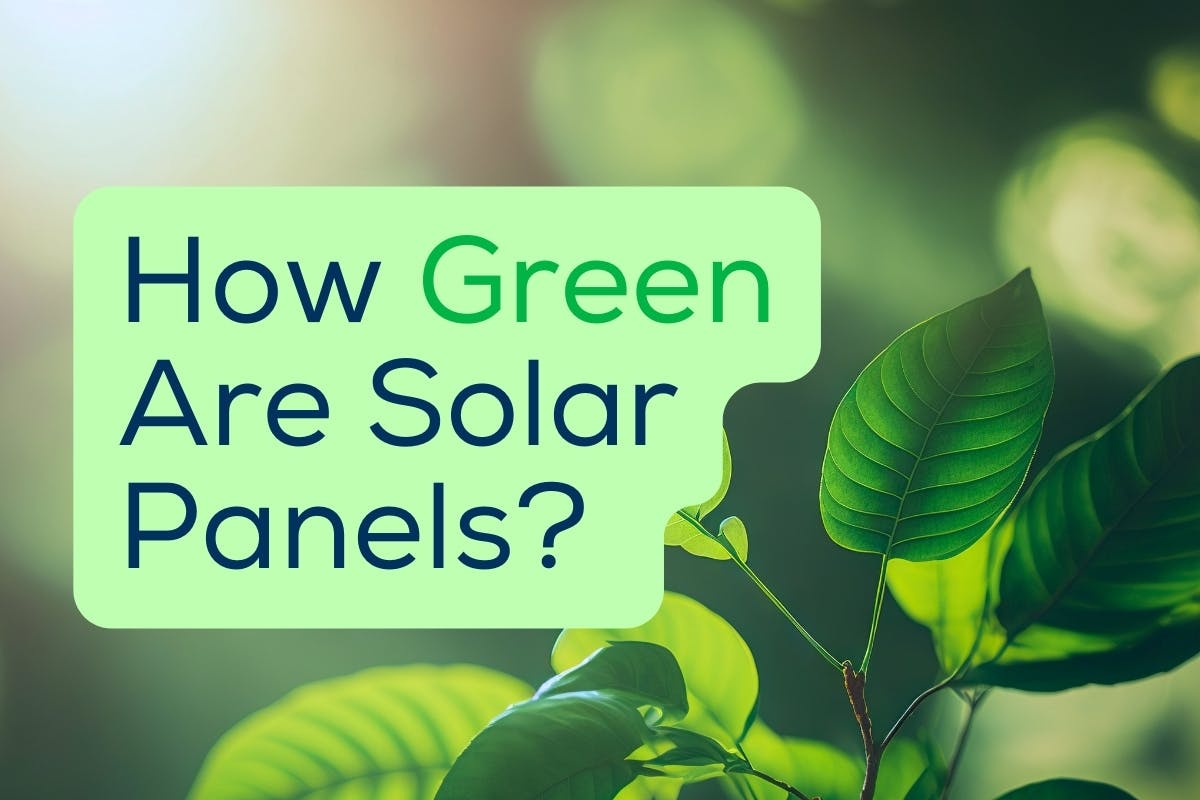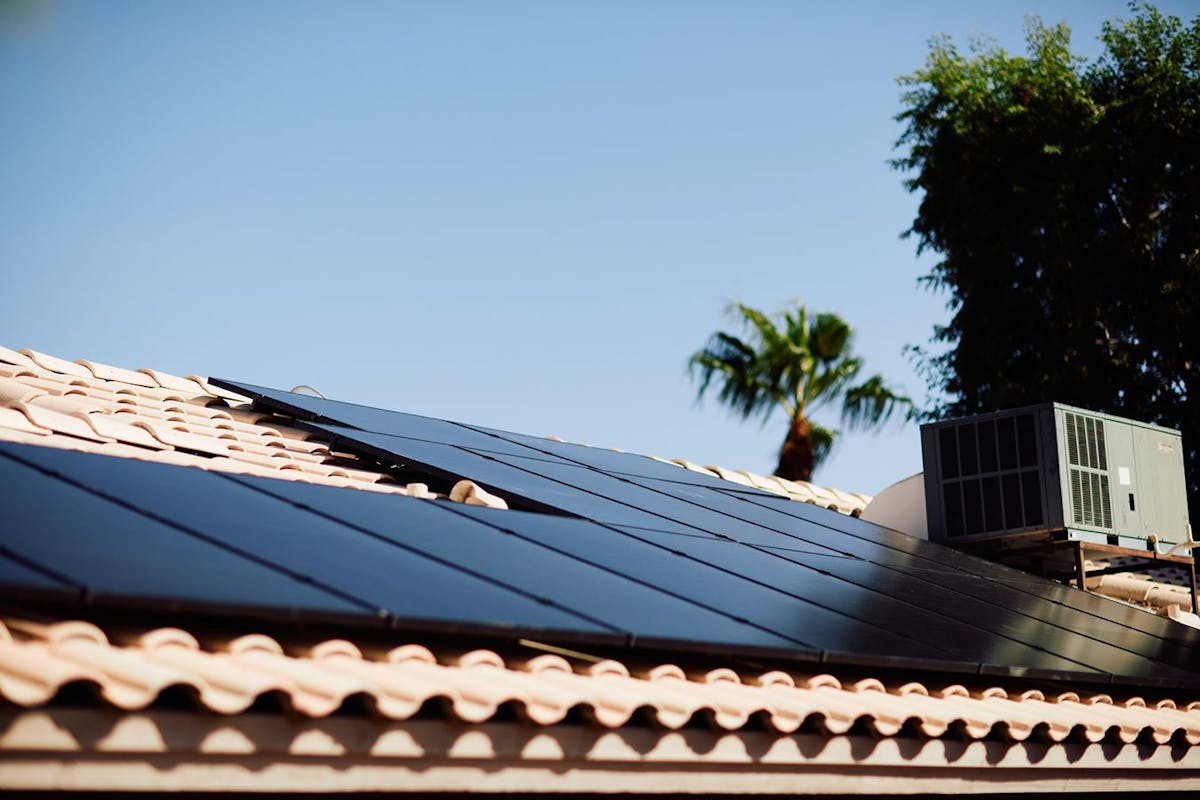How Green Are Solar Panels and Solar Power?
Last edited

Author
Andrew Giermak
Solar and Electrification Writer and Editor

Editor
Andrew Blok
Electrification and Solar Writer and Editor

What is black or blue, but always green?
A solar panel, of course!
Ok. But what makes solar panels and solar power “green” as in being clean and healthy for our environment? Solar panels have always been associated with renewable electricity generation and clean, emission-free solar power is more important to a greener future than ever.
In this article, we will explain how solar panels are important to our future energy usage while working as a growing home energy option for millions of Americans.
See how much you can save by going solar with Palmetto
What’s it Mean to be Green?
When Kermit the Frog sang, “It’s not easy being green,” he was probably not alluding to his carbon footprint.
Although “green” is used to describe several different things (including Kermit’s color or in reference to someone new or naive to something), today, most people relate “green” or “going green” with anything with a positive environmental impact.
While people throughout history have explored the benefits of environmentally-conscious living, the idea of “going green” gained significant momentum in the US during the 1970s and 80s in response to the negative human impact on air, water, and land contamination.
Today, individuals have opportunities to go green in many different aspects of life, from reducing food waste to lowering fossil fuel consumption, conserving water, and supporting businesses with sustainable operations.
Green Energy and Greenhouse Gases: Key Terms
Before we can illustrate precisely how green solar panels are, let’s first define a few related key terms to help put solar's health and environmental benefits into context.
| Term | Definition |
|---|---|
| Carbon footprint | The amount of carbon dioxide (CO2), methane (CH4), and other greenhouse gases emitted as a result of the activities and consumption of a person, group, or business |
| Greenhouse gases (GHG) | Gases that trap heat in the atmosphere and contribute to global warming |
| Green energy | Any form of energy that comes from natural sources, such as wind, sunlight, or water |
| Clean energy | Any energy source that emits negligible pollution, greenhouse gases, or chemical contaminants |
| Renewable energy | Any energy source that replenishes itself over a relatively short time frame (i.e., wind, hydropower, or sunlight) |
| Fossil fuels | Non-renewable resources found beneath the surface of the earth, including coal, oil, and natural gas |
So while the differences between green, clean, and renewable energy may be subtle, the impact of adopting such resources is highly significant. Compared to fossil fuels, renewable resources like solar energy are not limited in total fuel supply, nor do they emit nearly as many harmful greenhouse gases (GHG) into the atmosphere.
See how much you can save by going solar with Palmetto
So… How Green Are Solar Panels?
What makes solar energy green is a combination of a few different things. Compared to fossil fuels and other energy resources, the green powers of solar panels can be found in the sustainability of their materials, operation, and integration with new technologies.
Unlimited, free energy source
Unless a vengeful, money-motivated energy mogul finds a way to block out the sun, à la Mr. Burns in the Simpsons, solar power will always be “free” to generate. Although solar panels and related equipment obviously cost money to manufacture and install, the almost unlimited green energy potential of daily sunlight allows users to generate power with no additional fuel costs for 25 years or more.
Emission-free power
In operation, solar panels are much kinder to the environment than most power plants. Solar panels do not release any of the consequential greenhouse gases produced in other forms of energy generation. Each solar system, from residential-size to large utility-level systems, gives decades of emission-free power.
Abundant and recyclable materials
Solar panels are made from some of the most abundant materials on the planet, including parts that can be recycled and used in future equipment. While solar recycling programs are emerging and developing worldwide, many opportunities are being created to repurpose aluminum frames, glass, wiring, plastic, and other panel components used in the manufacturing process.
Easy integration and endless innovation potential
When looking at solar technology as a whole, one must consider how it can relate to the world of tomorrow. Generating electricity anywhere the sun shines, solar is a perfectly green candidate to support growing electricity demands, power EV charging stations, integrate into building materials, assist in emergency relief efforts, and more.
One Solar Energy System’s Impact
If you wonder how much switching to solar could reduce your carbon footprint, it may be more significant than you think.
Although US greenhouse gas emissions from electricity production decreased by about 3% 1990 to 2022, the American power grid is still far from “green,” but solar is helping.
In 2023, one-fourth of US greenhouse emissions were caused by electric power production. This is mainly because coal and natural gas made up 60% of the electricity produced that year. So although some parts of the country run entirely on renewables (like hydropower, wind, and solar) and others purely on coal-fired power, let’s assume the average American household’s grid-supplied electricity is about 60% fossil-fuel based.
A national average of 10,791 kilowatt-hours (kWh) consumed per year equates to a typical American home consuming about 6,475 kWh (60% of 10,791) of electricity generated by coal or natural gas annually. Avoiding 10,791 kWhs of grid energy (using the national average emissions rate), would avoid 8 tons of carbon dioxide equivalent, according to the Environmental Protection Agency’s (EPA) greenhouse gas equivalencies calculator.
In other words, by installing solar panels, you can essentially prevent the environmental equivalent of 8,053 pounds of coal-fired electricity production and avoid the equivalent of driving a gas-powered car for more than 18,000 miles or charging more than 580,000 smart phones. And, with a new home solar system, you’ll see these savings for 25 years or longer.
This math is a little too neat, since most people who go solar still consume some electricity from the grid. It does show that solar panels on just one roof can avoid significant greenhouse gas emissions.
Even better, solar panels can also help you save significant money on your electricity bills while producing that green electricity. When you go solar with Palmetto, we work with you to minimize your environmental impact and maximize your savings.
To get started, you can calculate your solar savings or contact us today.
See what solar can do for you:
Frequently Asked Questions
What is renewable energy?
Renewable energy is energy from a source which is naturally replenished. Solar, wind, and hydropower are examples of renewable and virtually limitless sources for energy.
How much do home solar panels cost?
The average cost of solar panels in the fourth quarter of 2024 was estimated at $3.33 per watt according to the Solar Energy Industries Association. The full cost for a specific home varies due to many factors including financing, location, your property, system size, panel make and model, tax credits and other incentives, local permitting and utilities, and the solar company.


